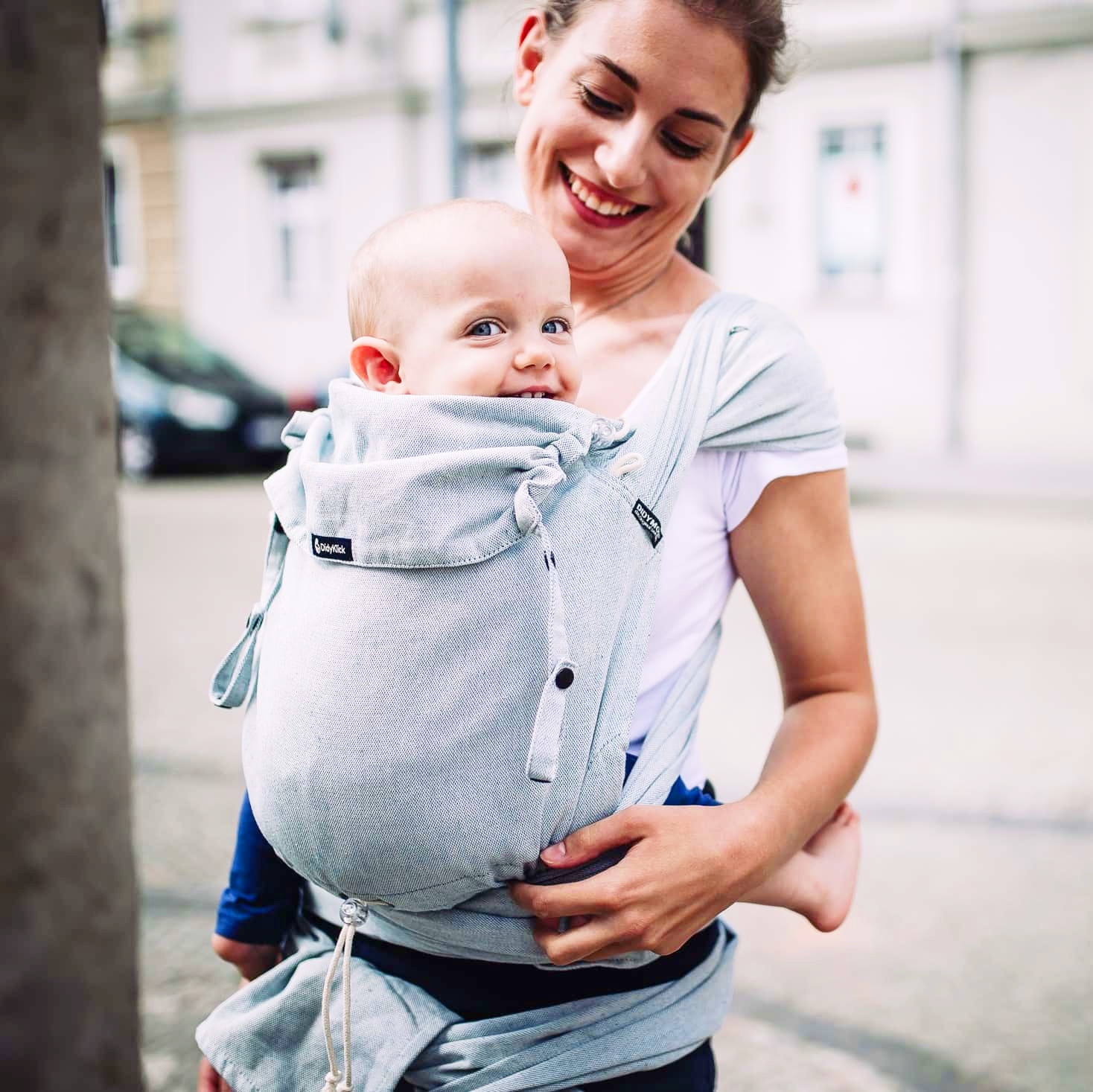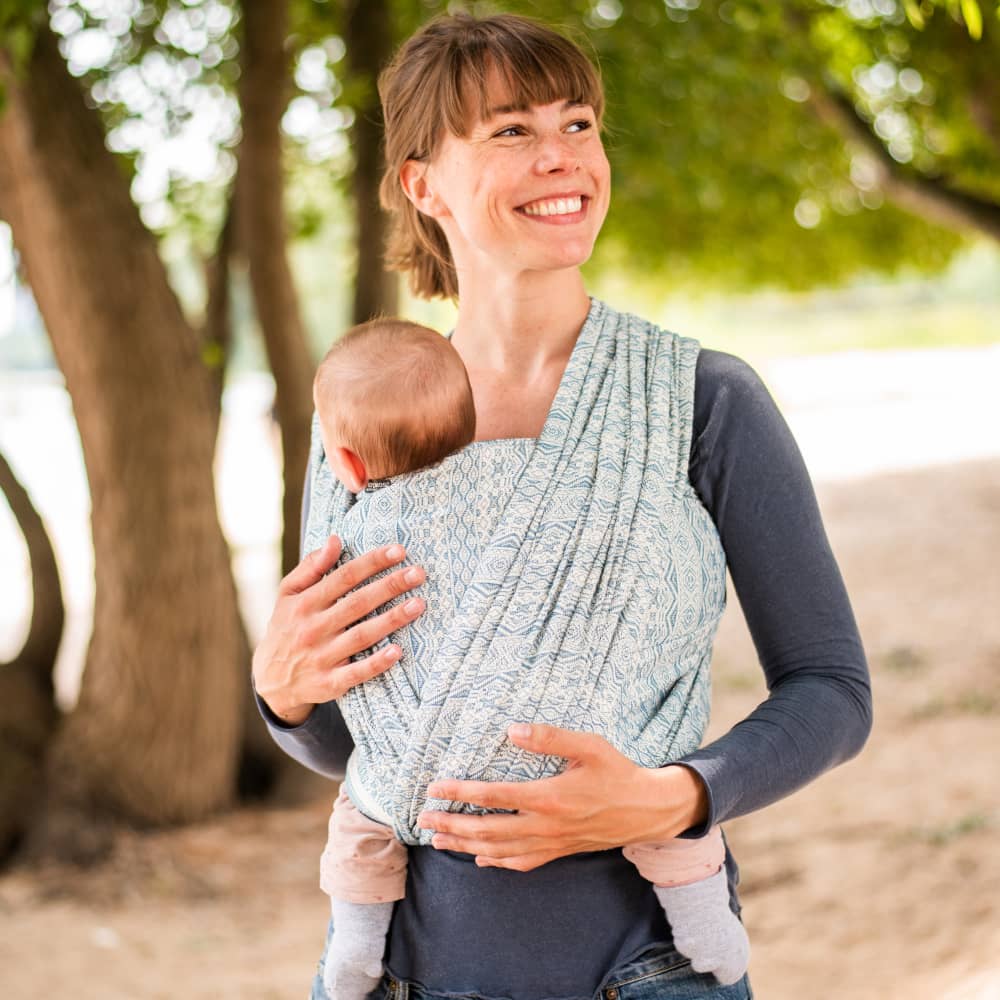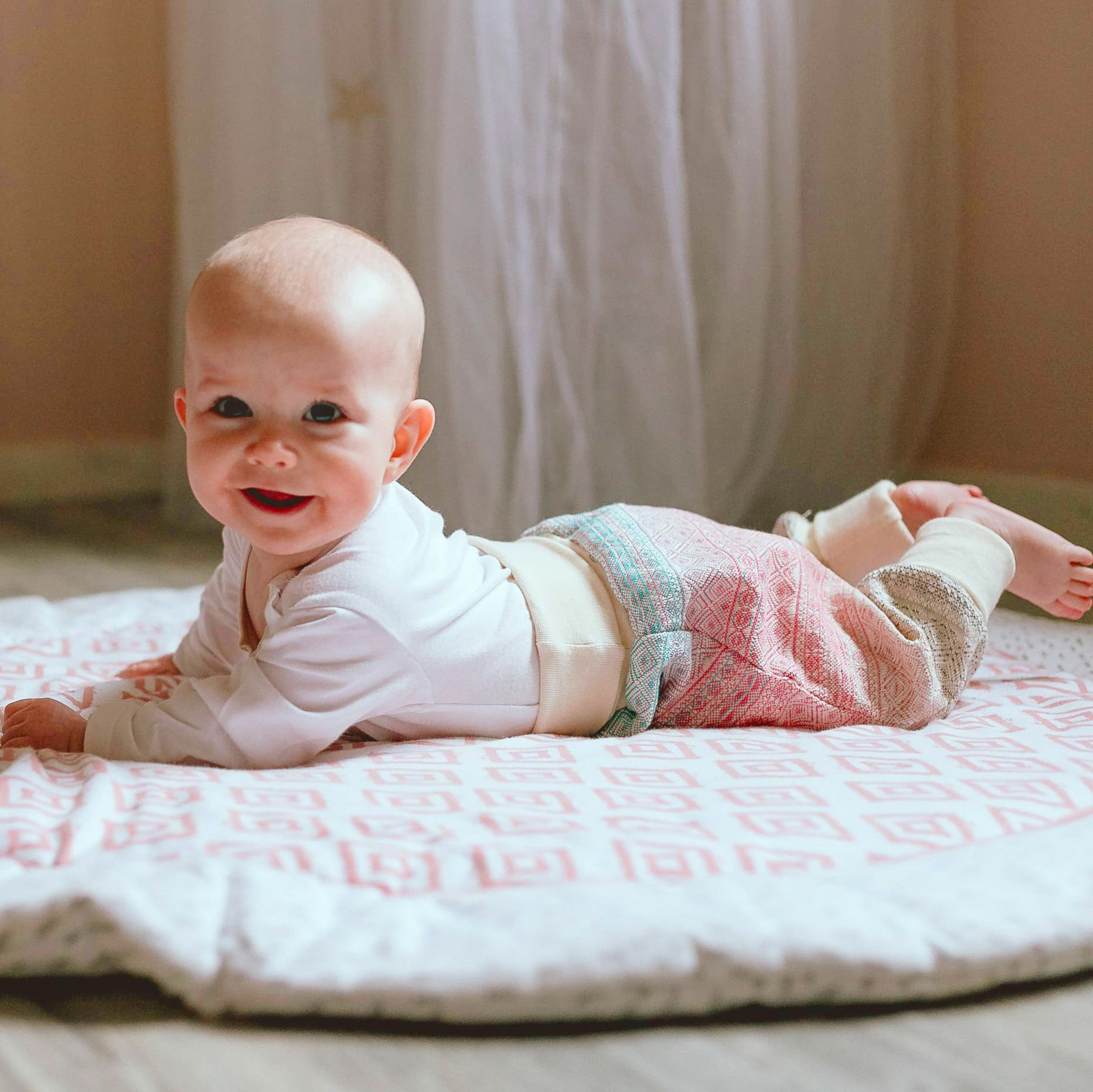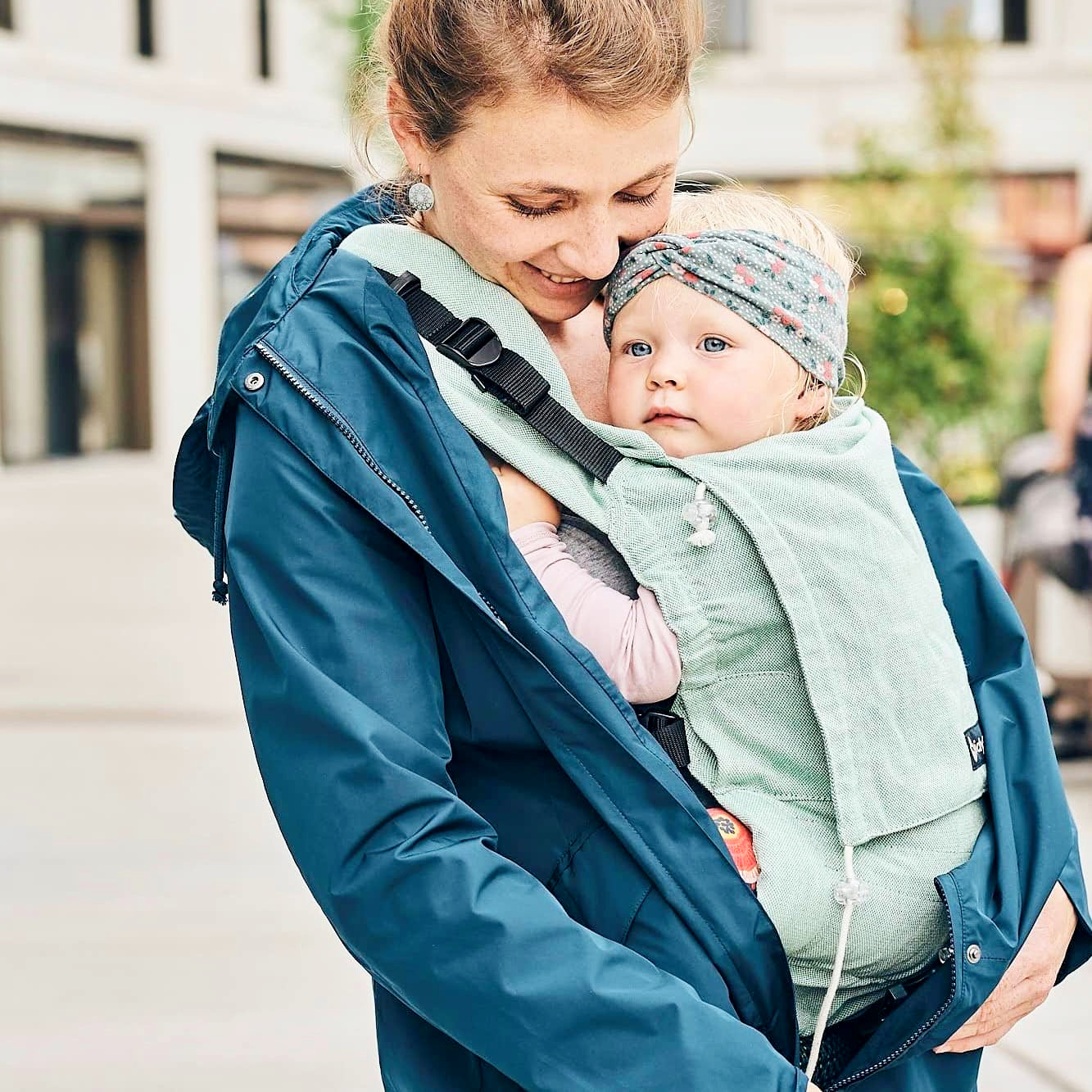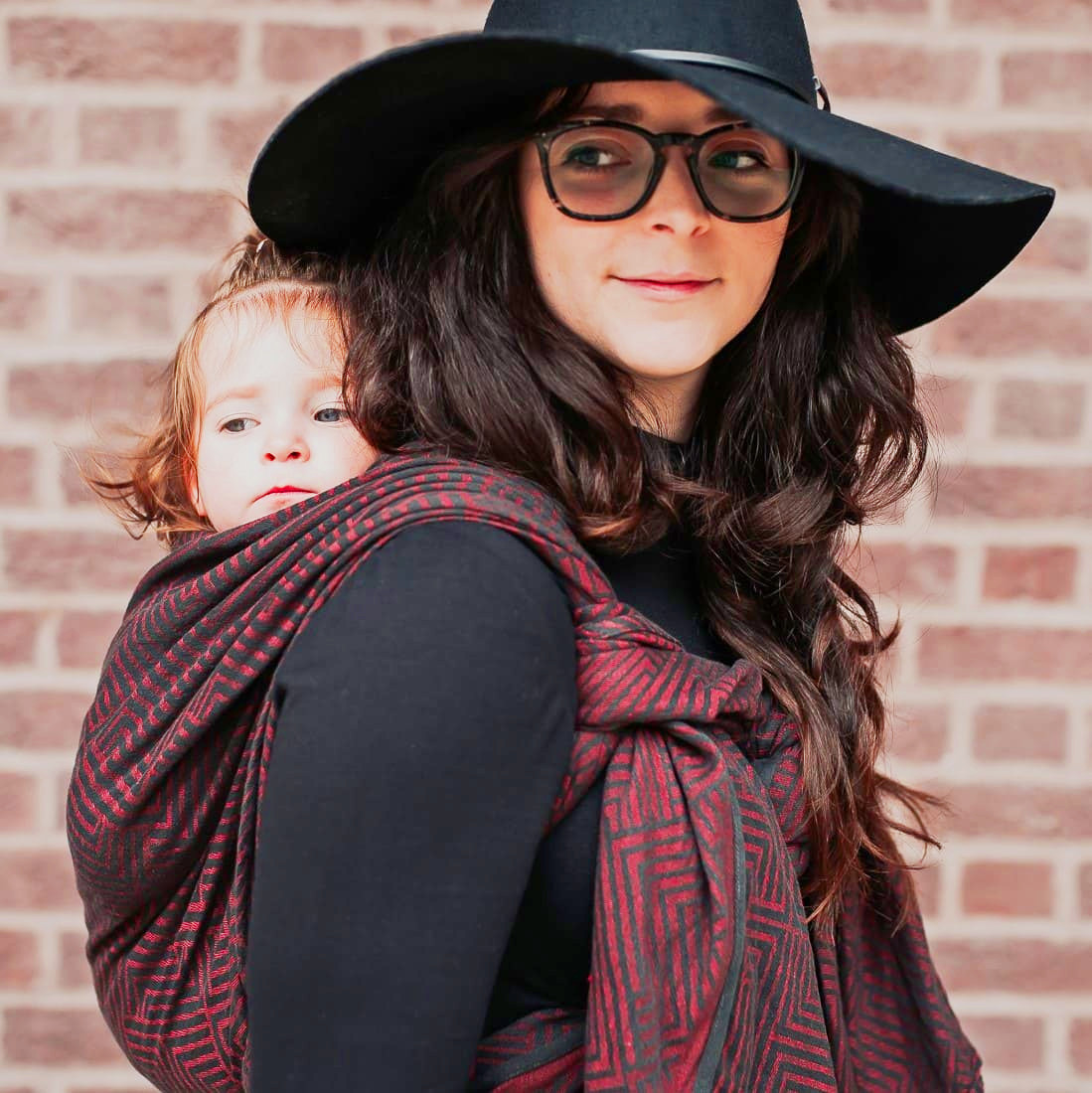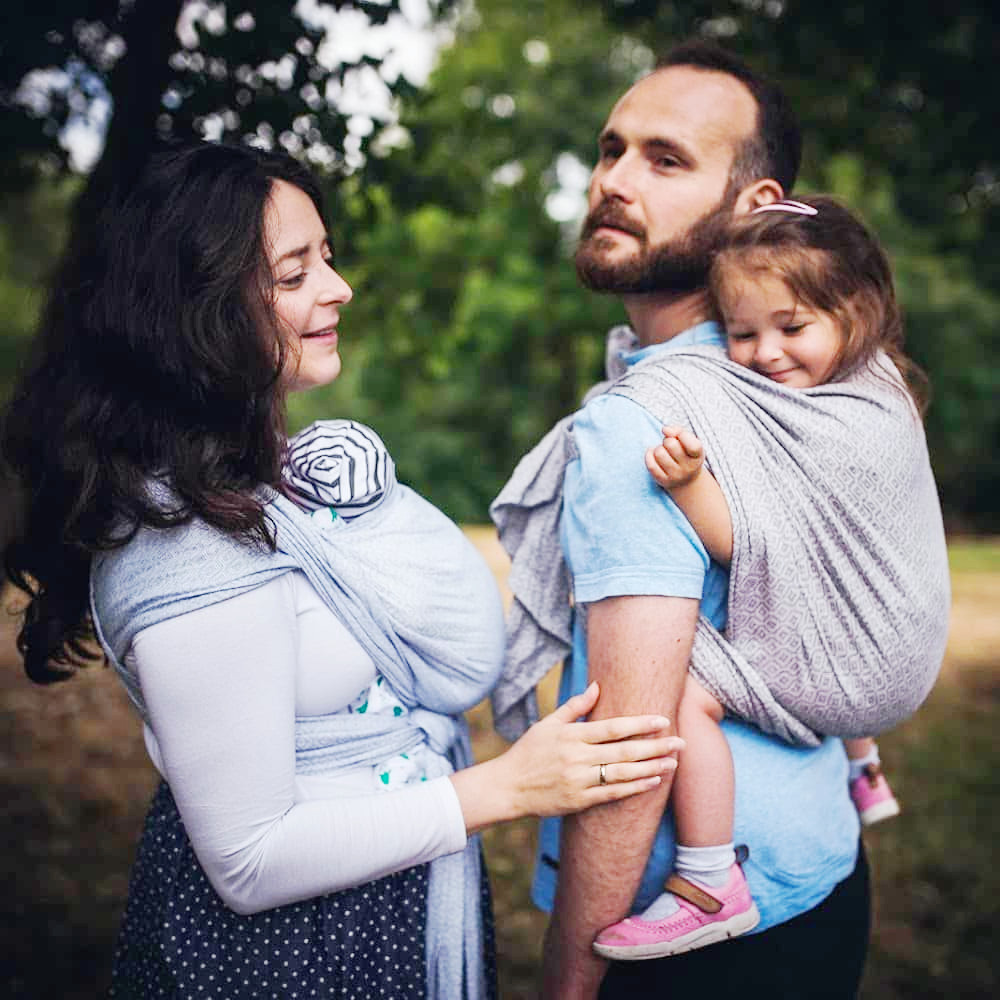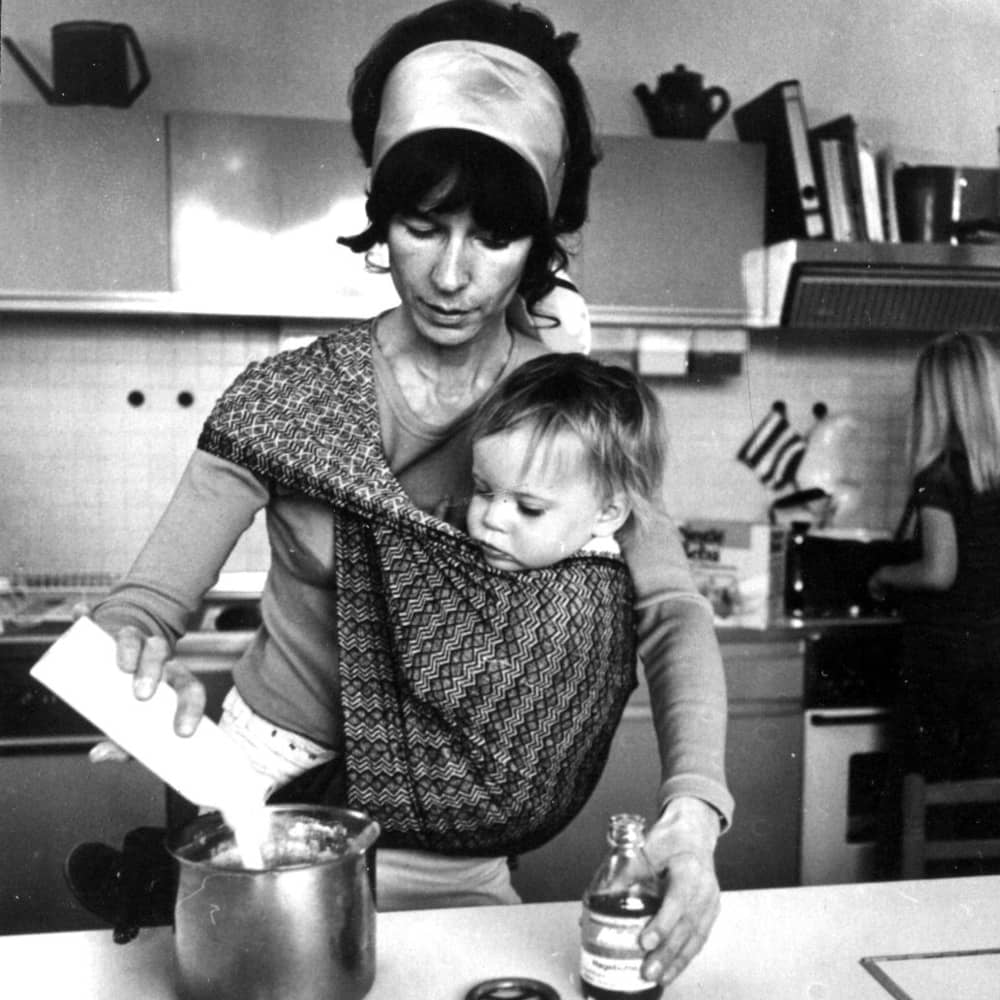FAQ
Carrying Babies and Toddlers

You can start carrying your baby from her first day of life. Nevertheless, the new mother should be mindful of her body’s messages in the postpartum period - and, if possible, leave the carrying to others.
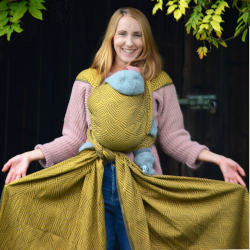 The length of the sling you need depends on your clothing size and how you want to tie it. We have developed an interactive size advisor to help you estimate which size wrap is ideal for you.
The length of the sling you need depends on your clothing size and how you want to tie it. We have developed an interactive size advisor to help you estimate which size wrap is ideal for you.
If you are unsure, please call us or send us an email.
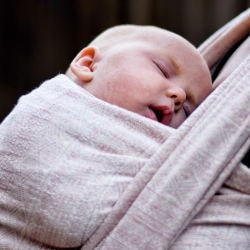 Many babies and children like to fall asleep while being carried and can easily spend a large part of the day in the sling or carrier. This is perfectly okay! As long as both the wearing adult and baby are comfortable, there is no such thing as too long. Naturally, over the course of the day, children are taken out of the sling or carrier for nappy changes and feeding. Riding in a car or on a bike are not appropriate when you're wearing your baby.
Many babies and children like to fall asleep while being carried and can easily spend a large part of the day in the sling or carrier. This is perfectly okay! As long as both the wearing adult and baby are comfortable, there is no such thing as too long. Naturally, over the course of the day, children are taken out of the sling or carrier for nappy changes and feeding. Riding in a car or on a bike are not appropriate when you're wearing your baby.
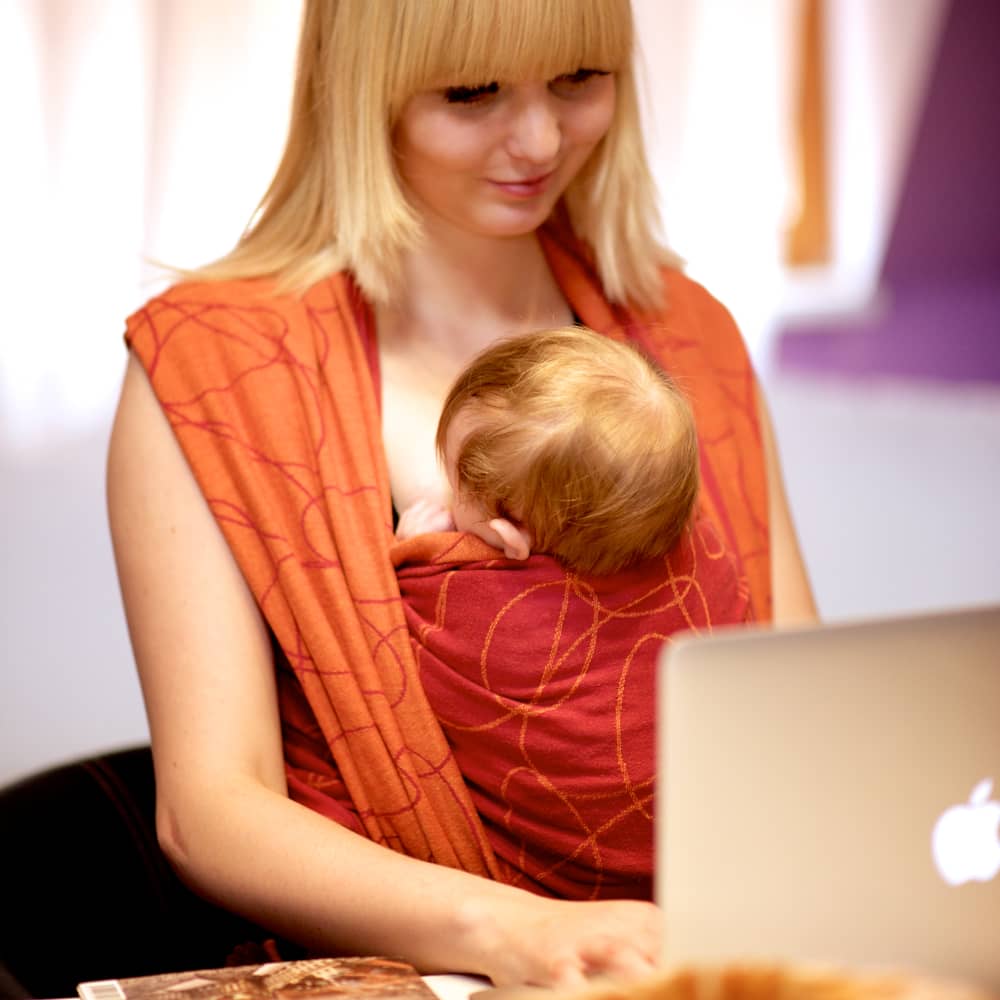 Please always pay attention to the following when you are carrying your baby:
Please always pay attention to the following when you are carrying your baby:
- Clear airways
- Upright position
- Supported (rounded) back
- M-shaped straddling position and
- Support from the back of one knee to the back of the other knee
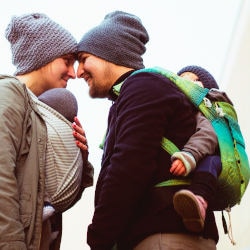 Carrying systems are like shoes – no single shoe fits everyone. It is therefore best to check out the different systems in advance and, best of all, to try them out - on our website, at a babywearing consultation or in our shop. We are also happy to send out different slings and carriers for you to test within Germany.
Carrying systems are like shoes – no single shoe fits everyone. It is therefore best to check out the different systems in advance and, best of all, to try them out - on our website, at a babywearing consultation or in our shop. We are also happy to send out different slings and carriers for you to test within Germany.
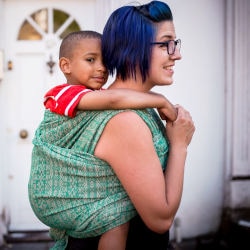 Our carriers are tested up to a weight of 20 kg. Woven slings could also be used beyond that, while our jersey slings can be used up to 20 kg. You will always find the weight limits marked for the individual carriers.
Our carriers are tested up to a weight of 20 kg. Woven slings could also be used beyond that, while our jersey slings can be used up to 20 kg. You will always find the weight limits marked for the individual carriers.
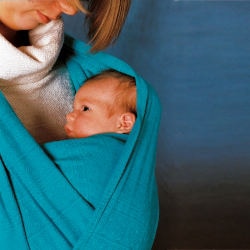 There are different options: for small children, the edge of the wrap can be folded over a small piece of fabric, e.g. a muslin cloth, to make a head support. If the child falls asleep on your back, a doll sling can be used to stabilise the head. Here, too, it is a matter of trying things out and, if necessary, having the various options shown to you in a babywearing consultation.
There are different options: for small children, the edge of the wrap can be folded over a small piece of fabric, e.g. a muslin cloth, to make a head support. If the child falls asleep on your back, a doll sling can be used to stabilise the head. Here, too, it is a matter of trying things out and, if necessary, having the various options shown to you in a babywearing consultation.
Absolutely not! The child assumes the spread-squat position when being carried, which is very comfortable on the one hand, and on the other hand is extremely beneficial for the healthy development of the hips. You are welcome to try it yourself and squat down - it’s certainly comfortable on the edge of a hammock.
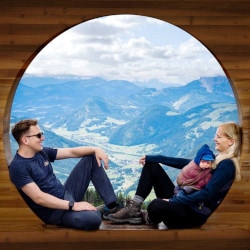 Yes, you can sit down while carrying your baby, as long as you are comfortable. But please note: If you want to sleep, please put the child down first.
Yes, you can sit down while carrying your baby, as long as you are comfortable. But please note: If you want to sleep, please put the child down first.
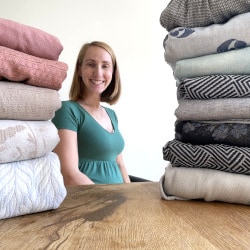 One sling or carrier is sufficient for carrying - a second one is recommended as a replacement in case you need to wash the first. If you would like to try out different materials, colours, patterns and systems, you will find a large selection in our shop. Or you can use our DIDYMOS rental service to try them out within Germany.
One sling or carrier is sufficient for carrying - a second one is recommended as a replacement in case you need to wash the first. If you would like to try out different materials, colours, patterns and systems, you will find a large selection in our shop. Or you can use our DIDYMOS rental service to try them out within Germany.
Tights, stockings, sleepsuits, and other all-in-one clothing items can exert too much pressure on your baby's toes and feet if the clothing is too small or if extra fabric collects behind your baby's knees. Therefore, make sure that you choose loose-fitting tights or one-piece suits and as a last step, pull the excess fabric down from the back of the knees after tightening your carrier.
Absolutely not! In fact, ergonomically correct babywearing is extremely beneficial for your baby's physical and mental health. Contrary to any claims of harm, we have compiled a list of good reasons to carry your child in a carrier and many experts agree it’s advantageous.
Humans are a carried species – we evolved to carry our babies. The practice of carrying has many physiological and bonding advantages. At the same time, there is nothing wrong with the (additional) use of a pram as long as your baby is happy with it.
No, you should not fall asleep whilst carrying your child in a baby carrier or sling. A secure carry with free airways must be maintained at all times.
Wearing and Tying Methods
The great thing about slings is that there are so many possibilities! You can discover the tying method that suits you and your child best by trial and error. Take a look at our tutorials or contact a babywearing consultant.
For the early days and weeks, however, the wrap cross carrying position has proven itself in any case. The wrap holds your child securely against your body. By the way, it is also the first choice when the DIDYMOS sling is used in a clinic.
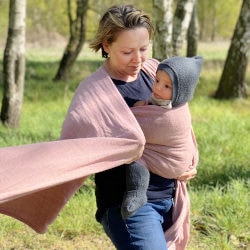 The wrap cross carry, the double cross carry or the kangaroo carry are particularly suitable for beginners.
The wrap cross carry, the double cross carry or the kangaroo carry are particularly suitable for beginners.
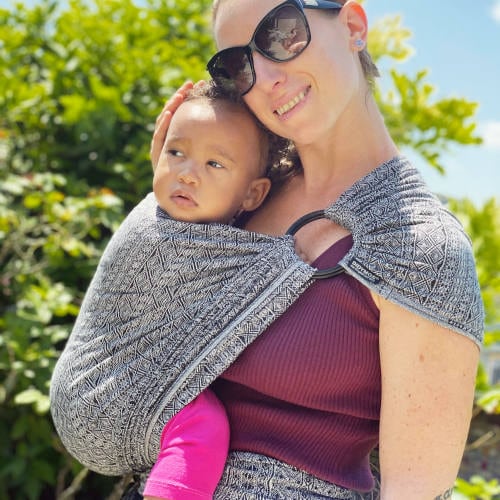 Yes, in fact this is possible with almost all of our products. A short baby sling or a DidySling have proved particularly suitable for this.
Yes, in fact this is possible with almost all of our products. A short baby sling or a DidySling have proved particularly suitable for this.
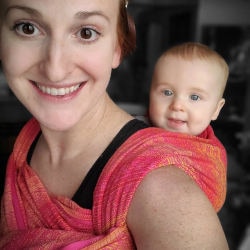 Experienced babywearers can carry their child on their back from birth. However, if you are still unsure about the backcarrying method or are just learning it, it is advisable to wait for full head control before you start with your first attempts. This is usually the case at 4 months or a little later.
Experienced babywearers can carry their child on their back from birth. However, if you are still unsure about the backcarrying method or are just learning it, it is advisable to wait for full head control before you start with your first attempts. This is usually the case at 4 months or a little later.
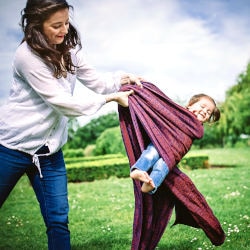 There are several ways to do this - we recommend pre-wrapping the baby and then either gently sliding the baby onto your back ("Santa Toss") or pushing the baby onto your back via the hips. Be sure to practise this tying method without the child at first, then stand on a soft surface for the first few times or have someone support you. You can also take a look at our tutorials.
There are several ways to do this - we recommend pre-wrapping the baby and then either gently sliding the baby onto your back ("Santa Toss") or pushing the baby onto your back via the hips. Be sure to practise this tying method without the child at first, then stand on a soft surface for the first few times or have someone support you. You can also take a look at our tutorials.
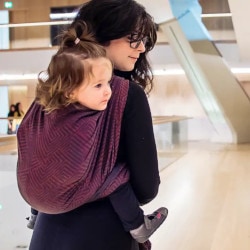 We have created numerous tutorials on all the popular tying and carrying methods as well as on our different products.
We have created numerous tutorials on all the popular tying and carrying methods as well as on our different products.
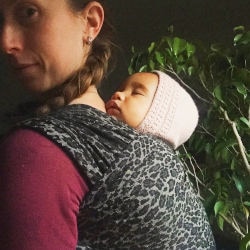 As a rule, parents tend to tie their children too loosely rather than too tightly in the beginning. To be on the safe side, do the following test: can you get your thumb comfortably but just barely between the back of your baby’s knee and the sling? If there is not enough room for your thumb, you can loosen the sling a little.
As a rule, parents tend to tie their children too loosely rather than too tightly in the beginning. To be on the safe side, do the following test: can you get your thumb comfortably but just barely between the back of your baby’s knee and the sling? If there is not enough room for your thumb, you can loosen the sling a little.
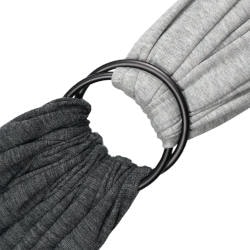 Rings are a great accessory for tying knotless finishes. They are also an integral part of our DidySlings, used to loosen and tighten the carrier.
Rings are a great accessory for tying knotless finishes. They are also an integral part of our DidySlings, used to loosen and tighten the carrier.
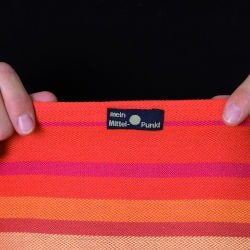 Our DIDYMOS slings have had a centre point ("Mein Mittelpunkt") as standard for many years, which makes the middle of the sling easy to find. If this centre label is missing from your sling, it is probably an older or shortened sling. If necessary, you can make the centre visible on your own, e.g. by embroidery.
Our DIDYMOS slings have had a centre point ("Mein Mittelpunkt") as standard for many years, which makes the middle of the sling easy to find. If this centre label is missing from your sling, it is probably an older or shortened sling. If necessary, you can make the centre visible on your own, e.g. by embroidery.
You can carry your baby on your hip from birth if you are experienced in carrying. Otherwise, ask a qualified babywearing consultant to show you how to carry your baby on your hips. As soon as your baby can hold his or her head, you can try it yourself without worry. You can find out how to do this in our tutorials.
About DIDYMOS Baby Carriers
Whatever is most comfortable for you and your baby - that is best for you. Basically, the baby sling is the gold standard against which every baby carrier should be measured. This is the case with all our baby carriers (see also: Which sling or baby carrier should I buy?).
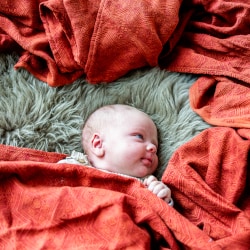 Our carriers are all sewn from our own woven sling fabrics.
Our carriers are all sewn from our own woven sling fabrics.
In summary, our DidySnap is a full buckle sling, while our DidyKlick is a half buckle sling. The Didy Meh-Dai (DidyTai) has no buckles at all and can be tied individually, while the Didy Onbuhimo (DidyGo) has no hip belt, which allows the baby to be carried up and down very quickly. You can find more detailed information on our product pages. Click here to go to our comparison of baby carriers.
With our baby carriers (except DidyGo and DidyKlick 4u Toddler) you can carry your child from birth or 3.5kg.
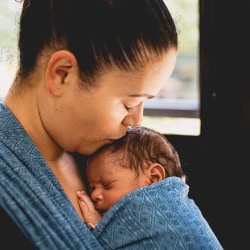 Correctly adjusted, any of our baby carriers are suitable for newborns (except our Didy Onbuhimo). The DIDYMOS sling is always the easiest to adjust because it is infinitely variable. Please always make sure that your child is correctly seated and adequately supported and contact a babywearing consultant or us if you are unsure. (See also: What should I pay attention to when carrying my child).
Correctly adjusted, any of our baby carriers are suitable for newborns (except our Didy Onbuhimo). The DIDYMOS sling is always the easiest to adjust because it is infinitely variable. Please always make sure that your child is correctly seated and adequately supported and contact a babywearing consultant or us if you are unsure. (See also: What should I pay attention to when carrying my child).
Put the child in front of the waist belt and not on top of it. This helps to prevent the belt from crumpling.
We also offer our straps in extra long or short. Just contact us and we will exchange your belt. If your belt is too long, you can also try putting it on the longest setting and double wrapping it.
Unfortunately, this is not always possible, but whenever we can, we will try to fulfil your requests. Just get in touch with us.
Every child is different. Therefore, we advise waiting until after birth before buying a baby carrier so you can try them out together to discover which carrying system works best for you. Since there are many different carrying systems, you can discover the different options during pregnancy using our babywearing advisor.
Depending on how your pregnancy progresses, a baby wrap can also be helpful before you give birth, as there are different tying techniques to relieve different discomforts during pregnancy. A babywearing consultant can help you here.
The gold standard for carrying a newborn is our DIDYMOS baby wrap sling, as it always fits the carrying adult and baby perfectly. You can choose between a woven wrap and a stretchy jersey wrap.
Our DIDYMOS baby carriers are a good alternative for babywearing beginners who are not (yet) confident in tying the sling. Four of our carriers can be used from birth, only the DidyGo and DidyKlick 4u Toddler are for larger babies.
Our interactive baby carrier advisor can help you choose the right baby carrier. You are also welcome to contact us at any time if you have any questions.
The best carrying method is the one that suits you, your child and your needs and that you feel comfortable in. You should make sure that your baby has a secure hold, a free airway, an upright posture and an ergonomic spread squat position, as well as comfortable weight distribution for you.
Our interactive baby carrier guide can help you choose the right baby carrier. You are also welcome to contact us at any time if you have any questions.
Carrying in Special Situations
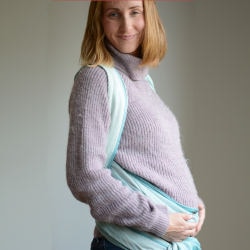 At the end of the day, we carry our children regardless. However, carrying with a sling or a baby carrier is much gentler on our bodies. Therefore, there is nothing to stop a pregnant person from continuing to carry her child, as long as you feel comfortable and there are no medical reasons not to do so. Carrying methods without a belly or hip belt that could press on your abdomen are particularly suitable, such as the Didy Onbuhimo or the simple ruck carry with a sling, when the child is carried on your back.
At the end of the day, we carry our children regardless. However, carrying with a sling or a baby carrier is much gentler on our bodies. Therefore, there is nothing to stop a pregnant person from continuing to carry her child, as long as you feel comfortable and there are no medical reasons not to do so. Carrying methods without a belly or hip belt that could press on your abdomen are particularly suitable, such as the Didy Onbuhimo or the simple ruck carry with a sling, when the child is carried on your back.
After a caesarean section, a tying method is recommended in which the knot of the sling runs above the scar, e.g. the kangaroo carry. If you use a carrier, such as the DidyKlick, you should make sure that the waist belt is also above the scar. As always, make sure the carrier or sling fits snugly and that the sling panels are fanned out over the shoulders and back to take as much weight off the abdomen as possible.
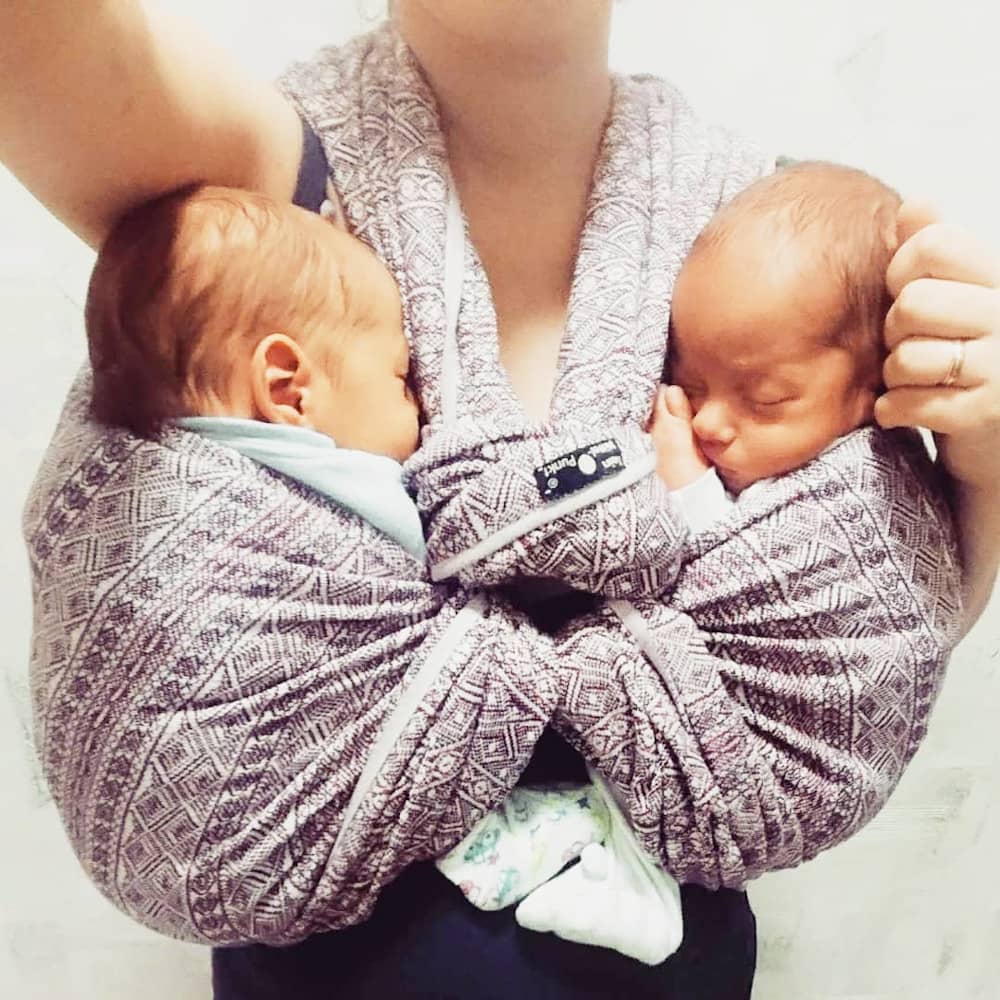 There are many tandem or twin carrying methods. On this page we have summarised the most important for you.
There are many tandem or twin carrying methods. On this page we have summarised the most important for you.
Premature babies can be carried early on on the ward and benefit considerably from this in their development. Please contact your hospital and/or an experienced babywearing consultant.
Absolutely! Babywearing acts like a massage on baby's tummy and has been shown to help reduce tummy aches.
By adopting the squat-spread position, carrying is beneficial for the healthy growth and development of the hip and is often a useful addition to therapy. However, always clarify the procedure in individual cases with the doctor treating your child and seek carrying advice if your child wears a spreader. A child with a harness can also be carried in the DIDYMOS sling or the Didy carriers on the body. Talk with us about the best way to tie the sling and we will be happy to advise you.
Yes, it is possible. There are no restrictions on babies wearing cloth nappies.
We offer our slings in many different lengths - you can use our interactive size advisor to find the right length for you. If the strap of our baby carriers is too short or too long for you, we will gladly exchange it for a suitable one.
Materials and Properties
Slings are made of threads of different materials that are woven together to create a fabric that is diagonally elastic. This is the only way the sling can fit around your child's body and support it entirely, like a big hand. We offer slings made of cotton, linen, hemp, silk, wool or cashmere.
For starters, a baby sling made of pure cotton is best, as it is easy to care for and handle and is quickly soft.
This weight measurement indicates the weight of the sling per square metre. Thus, the surface weight indicates how thick and heavy a sling is.
Here the preferences are quite individual, so it’s hard to say what’s best. For newborns and sensitive children, thin and soft fabrics made of fine materials, such as cashmere or wool, or our jersey slings, are generally very suitable, but heavy, denser slings made of hemp or linen can also be used for carrying newborns. For heavy babies and toddlers, thicker wraps with linen or hemp content are popular, but heavier tots can still be carried safely with thin fabrics.
Are you unsure about your choice? We will be happy to advise you.
No, a thread pull is primarily only a visual defect and the sling can be used without any concern. But if you know how, these can be easily fixed.
Even a single broken thread is usually not a problem and you can continue to wear the sling. Alternatively, the thread can be repaired by carefully knotting the ends and pulling them back in.
If you are unsure about the size of your sling, you can measure the long edge of your sling loosely in your hand with a tape measure and compare it with our standard sizes.
Our DIDYMOS slings are manufactured in Austria and Germany. Our baby carriers are sewn in Germany and the Czech Republic. You can read more about the production process here.
Care and Washing
Your new DIDYMOS baby sling should be washed before first use. This is not absolutely necessary for your baby carrier. However, the fabrics often become even softer after washing, so this little extra effort is definitely worth it.
Basically you can start immediately with any sling or carrier! However, some materials, such as hemp or linen, become even softer over time, so many people prefer a broken in wrap. You don't necessarily have to wear the sling to break it in - you can also use it as a blanket or hammock, cuddle with it or "crochet" it by knotting.
This depends on the material - please check the care label of your sling or baby carrier and/or refer to our material pages.
Nothing! Hard water can give the feeling that the sling or carrier is now hard and stiff. This will quickly disappear after a few wears. You can also put a cotton sling in the dryer for a short time at a low temperature so that it becomes nice and soft.
Cotton slings and carriers can be put in the dryer, all other materials should be air dried flat and not in direct sun.
Wash your sling or carrier as often as any other item of clothing, but at a minimum when it becomes soiled.
Please use liquid detergent without optical brighteners and no fabric softener! For woven wraps with wool, silk or cashmere, you will need a wool or silk friendly detergent.
Most slings are happy to be ironed while still slightly damp - but please be sure to check the care label!
Troubleshooting
Humans are a carried species - so it is extremely rare that a baby really doesn't want to be carried. It is more likely that she prefers another tying method or carrier. In this case it is a matter of: Try it out, preferably together with a babywearing consultant.
This can happen - especially if you are still unsure about tying the sling. With time, tying and adjusting the carrier happens very quickly and the child gets used to the process. Some parents also sway or move around while tying, which can defuse and distract from the situation.
But you will see: As a rule, your baby will calm down as soon as he or she is tied and you start moving.
It usually helps to stand as upright as possible when tying the wrap or to give the child an interesting toy to hold while tying. There are also some carrying methods that are particularly popular with "seat poppers". Talk with us about this, and we will be happy to advise you.
We recommend avoiding forward facing carrying, as the advantages of carrying are lost. If the child wants to see more, it is often helpful to carry the child in a different way, e.g. on your back or hip, so that the child can see forwards.
Carrying your child should not cause pain. Pain is usually an indication that something is wrong. Check that you are using a correct carrying method and that the sling or carrier is tied tightly enough. Try different options and if in doubt, please contact a babywearing consultant.
Carrying is extremely relaxing for babies and simulates time in the womb, especially through movement. When the baby is put down, the movement stops and the baby wakes up - this is quite normal. Practice putting the baby down without pressure from time to time - experience shows that it works best if you first put the bum down and then the baby over the side. The kangaroo carry is very suitable for putting the baby down - try it out!
If your sling loosens over time and slips down, you probably didn't tie or knotted it tightly enough, leaving fabric that sags with time and motion. Just untie the knot and tighten it again. Next time you can try pulling it a little tighter.
If the strap of your carrier is too short or long for you, you can simply exchange it for an extra short or long strap. If it is much too long for you, you can also pull it to the longest setting and double it.
Wearing at Different Times of the Year
Dress your baby normally - but note that the sling or carrier usually replaces a layer of clothing.
Basically, yes, because your child is well protected from overheating in the sling or carrier. However, please avoid the blazing midday sun and make sure your child wears adequate sun protection, including a sun hat and protection for legs and feet. Here you can find our tips for babywearing in summer.
Thin, airy wraps made of breathable materials such as linen, silk or hemp are suitable for summer.
Normally, your child is protected by your umbrella. Alternatively or additionally, a rain jacket with a hood is recommended. Here you can find our current range of carrying jackets.
It is best to carry small babies on your body and under your own jacket. Please have a look at our carrying guide Babywearing in winter.
Yes, but you should always carry your child on front, as you will usually fall backwards onto your bottom or back if you slip. Always make sure your footing is safe. If it is really slippery, it is better to stay at home. We also recommend spikes.
Even on hot days you can carry your baby in a baby carrier and she or he is well protected close to your body. Our DidySlings as well as the DidyFix and the DidyGo are particularly popular and airy baby carriers for the warmer seasons.
We have compiled our tips for carrying in the summer for you here.
Your child can wear what he or she would wear indoors under the babycarrying jacket. In addition, your baby will need a hat, a scarf, warm socks or furry shoes and gloves if necessary.
We have compiled detailed information on carrying in winter for you here.
This depends on whether you wear your baby over or under your jacket when using your baby carrier. We recommend carrying small babies under your jacket. If you want to wear your child over your jacket, we recommend a warm woollen overall. Thick snowsuits are unsuitable because of the air pockets in the material. Make sure to protect all parts of the body that stick out of the carrier such as baby’s legs and head.
We have compiled detailed information on carrying in winter for you here.
After the Wearing Period
There are lots of ideas for what you can do with your sling after the babywearing period is over. Here we have put together some ideas for you. If you also have an idea, please write to us or send us a photo.
If you want to store your baby sling for the next generation, make sure that it is in a clean condition. Slings are generally happy to be used from time to time. Linen slings in particular should be used or washed from time to time to prevent possible permacreasing.
Slings with wool or cashmere content should definitely be stored in an airtight container to protect them from moth infestation. Lavender pillows stored between the wraps can also protect them.
DIDYMOS Community
DISO stands for "Desperatly in search of". A DISO is therefore a sling that you desperately want and are looking for.
FSOT is the abbreviation for "for sale or trade". This abbreviation can be found in the various platforms where used baby carriers are sold or traded.
A DIP is a raffle of a baby sling that usually takes place in social network groups. Here, a "lottery ticket" can be bought for a certain amount of money, in exchange for which the sling is "sold".
DIB stands for "do inform before selling “ and results in a certain right of first refusal.

